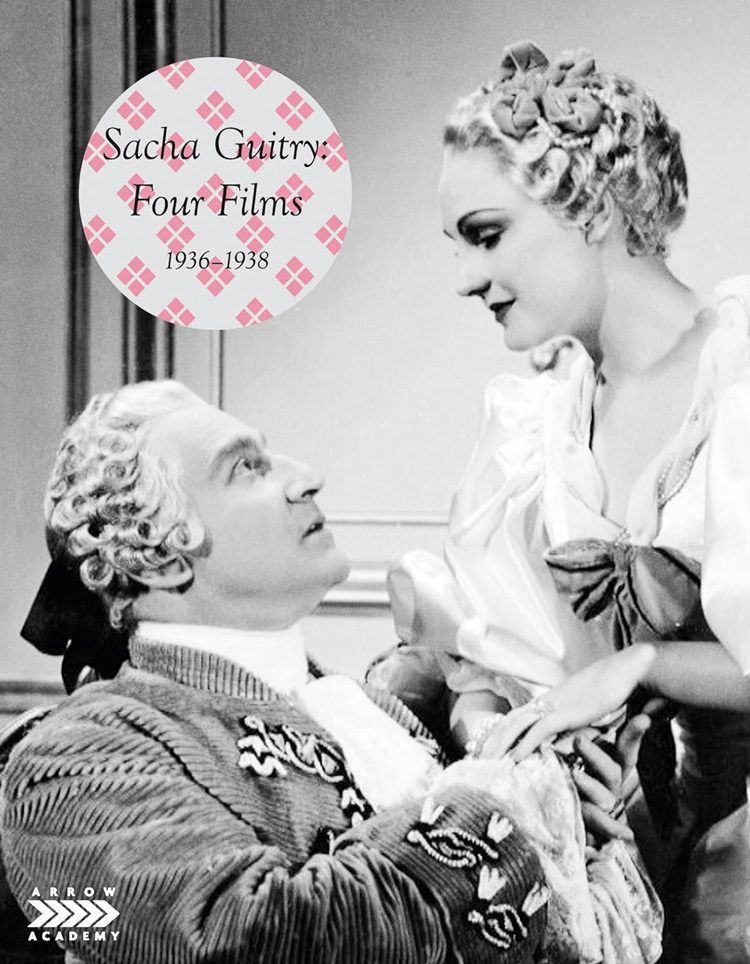
You could say Sacha Guitry was born into the theater. His father, Lucien Guitry, was a very famous French actor who was friends with such luminaries as Tchaikovsky (Guitry convinced the great composer to write his works for Shakespeare’s Hamlet). As a teenager, Sacha began writing for the stage. He was quite prolific at it, having penned more than 120 plays in his lifetime. As movies began taking cultural prominence over the stage, Guitry stayed in the theatre feeling that silent pictures without the use of dialogue were not as dramatically satisfying. By the 1930s, he had changed his mind and began writing, starring, and directing numerous films.
The liner notes for this Arrow Academy set call Guitry the “Gailic Noel Coward.” I don’t know enough of Coward’s work to say whether or not that is true, but Guitry’s films (at least the one contained in this set) seem, well, much more pedestrian than anything I’ve seen of Coward’s work. On both the stage and screen, Guitry seems to have created works for the masses not the intelligentsia. As Ginette Vincendeus notes in her introduction to this set, Guitry was known to be a bit of a misogynist. He was married five times (four to up-and-coming actresses whom he pushed into stardom – and to starring next to him) and there is plenty of that to be seen in these films. He never quite hits you over the head with a sledgehammer with it but it always seems to be there. Either in the way the women are treated or various jokes being made by the men.
The four films presented here (Let’s Make a Dream / My Father Was Right / The New Testament / Let’s Go Up the Champs-Élysées ) are kind of funny, and light, and very dated. I did notice that my wife, who is fluent in French, laughed quite a bit more than me. I’m not sure if that’s because some things get lost in translation, or that she caught more of the cultural jokes, or she’s just more prone to laughter than I am. While watching these films, I kept picturing myself sitting with some imaginary old French ladies who were cackling at the various mischiefs the characters were getting into. They are the sort of films people of a certain age and disposition would find hilarious. The sort of people who find a cuckold man the height of comedy.
They do have that old-movie sensibility wherein the important thing is not being natural or realistic, but rather setting up fairly ridiculous plots and allowing the characters to play off of them. Three of the four films were based upon plays by Guitry and those same three all take place in small rooms, are not opened up or shot in any cinematic way. The fourth film, Let’s Go Up the Champs-Élysées, tells the story of that famous street and actually feels like a real movie, not just a play on film.
Let’s Make a Dream finds Guitry playing a lawyer who seduces a young woman only to find problems with her husband the next day. It begins with a gypsy chorus played over the credits followed by a collection of sexist jokes by various men at play during a long party. This was probably my least favorite story. My Father Was Right finds Guitry playing the titular father as a relatively young man and then as a much older one, both giving advice to his son on women, the virtues of selfishness, and the horribleness of marriage.
Though its title may summon visions of Sunday school Bible stories, The New Testament is actually a family drama in which a man briefly disappears leaving behind a new will (or testament, if you will) in his jacket pocket. His wife reads it along with a set of friends only to find that they’ve all been cheating on each other with each other. Let’s Go Up the Champs-Élysées is the more exciting film of this set. While the other films were quite theatrical and all contained a certain contained parlor element to them, this one breaks out into some relatively interesting fantasy moments. Guitry portrays a number of characters all who detail the history of the boulevard.
All four films look decent, but not anything near great. There is pretty consistent grain throughout and regular occurrences of scratches and several moments of warped frames. But considering their age (and that they were originally made for television), this can be forgiven. There is nothing so bad as to be completely distracting or annoying. Audio is likewise okay. There is a noticeable hiss on each film and the dialogue can be a bit boxy. My wife had difficulty understanding some characters which was both because of the audio presentation and their accents.
The set is presented in a lovely solid box and comes with Arrow’s usual full-color (well, “full black and white” I should say as all the images come from early, non-colorized films) booklets with some nice essays. Extras include some screen tests, trailers, visual essays, and a nice introduction to Guitry and these films.
I cannot say that I fully recommend this set. Sacha Guitry was immensely popular in his time in France and therefore these films have a historical importance. They are also quite dated, plainly directed, and not all that funny. Arrow Academy has done their usual marvelous job of presenting the films and if you have interest in this sort of thing, then this is a really nice set.